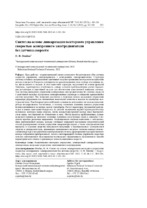| dc.contributor.author | Опейко, О. Ф. | |
| dc.coverage.spatial | Минск | ru |
| dc.date.accessioned | 2022-04-07T07:39:55Z | |
| dc.date.available | 2022-04-07T07:39:55Z | |
| dc.date.issued | 2022 | |
| dc.identifier.citation | Опейко, О. Ф. Синтез на основе линеаризации векторного управления скоростью асинхронного электродвигателя без датчика скорости = Synthesis Based on Linearization of Vector Speed Control of an Induction Motor without a Speed Sensor / О. Ф. Опейко // Известия высших учебных заведений и энергетических объединений СНГ. Энергетика. – 2022. – № 2. – С. 103-114. | ru |
| dc.identifier.uri | https://rep.bntu.by/handle/data/110969 | |
| dc.description.abstract | Цель работы – параметрический синтез векторного бездатчикового (без датчика скорости) управления электроприводом с асинхронным электродвигателем. Структура системы основана на применении адаптивной модели оценивания вектора потокосцепления ротора и скорости. Скорость оценивается по рассогласованию тока статора и величины тока, вычисляемого в модели. В этой известной структуре, полученной на основе функций Ляпунова, гарантируется устойчивость, однако остается проблематичным расчет параметров регуляторов и адаптивной модели для обеспечения качественной динамики системы. Для системы векторного управления асинхронным электродвигателем без датчика скорости с адаптивной моделью предложена линеаризованная структура в синхронно вращающейся системе координат. Это позволяет рассчитать с помощью метода модального управления параметры управления для обеспечения показателей качества в каждом из замкнутых контуров системы. Такой параметрический синтез основан на допущении, что потокосцепление ротора поддерживается постоянным, и поэтому взаимным влиянием каналов управления потокосцеплением и моментом можно пренебречь. Расчет параметров управления (регуляторов и канала адаптации) базируется на способе назначения корней характеристических полиномов контуров таким образом, чтобы каждый внутренний контур имел быстродействие выше, чем внешний по отношению к нему. Метод является приближенным, однако позволяет принять во внимание основные причинно-следственные связи в динамике и получить простые расчетные выражения. Моделирование системы выполнено с использованием имитационной модели, которая учитывает цифровой программно-алгоритмический способ формирования сигнала управления микроконтроллером, а также электромагнитные процессы в условиях широтно-импульсной модуляции в преобразователе электрической энергии и электродвигателе, применение оцениваемого моделью значения вектора потокосцепления ротора в координатных преобразованиях системы, формирование пространственного вектора напряжения преобразователя. Анализ синтезированной системы управления скоростью методом имитационного моделирования подтверждает эффективность предложенного способа параметрического синтеза и приемлемую точность оценивания скорости. | ru |
| dc.language.iso | ru | ru |
| dc.publisher | БНТУ | ru |
| dc.title | Синтез на основе линеаризации векторного управления скоростью асинхронного электродвигателя без датчика скорости | ru |
| dc.title.alternative | Synthesis Based on Linearization of Vector Speed Control of an Induction Motor without a Speed Sensor | ru |
| dc.type | Article | ru |
| dc.identifier.doi | 10.21122/1029-7448-2022-65-2-103-114 | |
| local.description.annotation | The aim of the work was parametric synthesis of vector sensorless (i. e. without speed sensor) control of an electric drive with an induction motor. The structure of the system is based on the application of an adaptive model for estimating the rotor flow coupling vector and velocity. The speed is estimated by the mismatch of the real stator current and the current value calculated in the model. Stability is guaranteed in this well-known structure, obtained on the basis of Lyapunov functions, but it remains problematic to calculate the parameters of regulators and an adaptive model to ensure high-quality dynamics of the system. For a vector control system of an induction electric motor without a speed sensor with an adaptive model, a linearized structure in a synchronously rotating coordinate system was proposed. This makes it possible to calculate control parameters using the modal control method to ensure quality indicators in each of the closed circuits of the system. Such parametric synthesis is based on the assumption that the flow coupling of the rotor is maintained constant, and therefore the mutual influence of the flow coupling and torque control channels can be neglected. The calculation of the parameters of control (regulators and the adaptation channel) is based on the method of assigning the roots of characteristic contour polynomials in such a way that each internal contour has a higher speed than the external one with respect to it. The method is approximate, but it makes it possible to take into account the main cause-and-effect relationships in dynamics and obtain simple calculation expressions. The simulation of the system was carried out using a simulation model that takes into account the digital software-algorithmic method for generating a microcontroller control signal, as well as electromagnetic processes under conditions of pulse-width modulation in an electric energy converter and an electric motor, the use of the values of the rotor flow coupling vector estimated by the model in coordinate transformations of the system, the formation of a spatial vector of the converter voltage. The analysis of the synthesized speed control system by the simulation method has confirmed the effectiveness of the proposed method of parametric synthesis and the acceptable accuracy of speed estimation. | ru |

